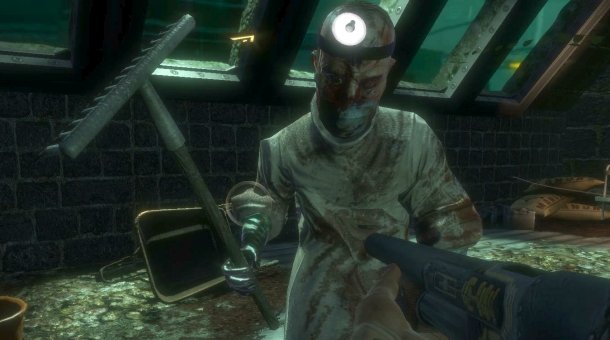Cool insights from a candid and funny BioShock developer commentary

JP LeBreton was the main designer on the planty bit of BioShock: Arcadia. He recently joined his friends from the Idle Thumbs podcast to play through some early sections of BioShock, including his own, and talk about how they were built and why. You can watch the whole thing on their Twitch TV channel (skip the first 5m 30s), but since I don't entirely trust you to do that on my vague recommendation, I'll mention a few of the many interesting things I learned from it to sway anyone who hasn't already clicked that link.
1. The Horror Pass
The designer of Thief 3's Shalebridge Cradle and BioShock's Fort Frolic, Jordan Thomas, did a 'horror pass' on BioShock: to go through the game and insert or enhance scary bits. The Cradle is famous for being one of the creepiest levels in a game, and it's interesting to see the horror elements of BioShock singled out. Separately, both JP and the designer of the Medical Pavilion used a cheap trick that makes me jump every time: that bit where you turn round to find a surgeon Splicer standing right behind you.
2. Don't Look at the Door
The cave-in that forces you to take a detour into Arcadia is triggered by walking through a particular chunk of space, and triggers a little earlier if you happen to be looking in the right direction as you approach. JP recalls a speed-runner figured out both these conditions, and managed to stack objects to climb a tree and jump over the trigger. Since he also knew that looking at the door would trigger the blockage, he had to do the whole thing while very purposefully looking the other way.
I don't think it's the exact one he's talking about, but the trick is used in the current record-holding speed run of BioShock: see part 6 of Mirko Brown's 1h 06m run .
3. Sisters Beyond Salvation
At one point, it wasn't possible to save Little Sisters. Your choice was to harvest them, killing the girl but giving you precious Adam, or stick to your principles and go without. I'm really sad they didn't stick with this - I adored the game, but it really bothered me that the mechanics actually bribe you to do the right thing, rather than forcing a choice between principles and pragmatism. I'm guessing the drawback was that moralistic players wouldn't compromise even if the difficulty became tedious, denying themselves both the Big Daddy boss fights and access to a broad set of plasmids, which are two pretty key parts of the experience. Seems like there are ways around that.
4. The Biogun
There's an odd looking thing on a workbench in the apiary of Arcadia, looks sort of like a weapon. It is a weapon, but it was cut: the Biogun was meant to be a sort of indirect utility weapon, firing a variety of things from Splicer repellent to bees. It was cut because that's what plasmids are for, and that's why we can fire bees from our hands. The story of the bee-ammo pickup is hilarious, and you should hear it for yourself.
5. Arkane's BioShock 2 Intro
Dark Messiah and Dishonored developers Arkane did contract work for BioShock 2, including a whole opening segment to the game that was never used. It started in the Kashmir restaurant in its prime, before the revolution that ruined Rapture, and before the decay that flooded it. You'd then flash forward to the same place during BioShock 2's time, completely underwater. It sounds great.
The biggest gaming news, reviews and hardware deals
Keep up to date with the most important stories and the best deals, as picked by the PC Gamer team.
The whole thing is a couple of hours long, in three parts, and very much worth watching. The Idle Thumbs podcast is also great - you can grab their latest ones on their Kickstarter page .

